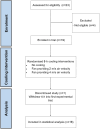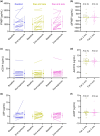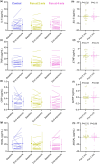Effect of pedestal fan use on serum stress biomarkers in older adults exposed to simulated daylong indoor overheating
- PMID: 40542541
- PMCID: PMC12181687
- DOI: 10.14814/phy2.70390
Effect of pedestal fan use on serum stress biomarkers in older adults exposed to simulated daylong indoor overheating
Abstract
There is an urgent need to develop targeted heat-alleviation strategies to protect heat-vulnerable older adults. We have shown that electric fan use had nominal impact on reducing body core temperature and cardiovascular strain during daylong exposure to simulated indoor overheating. Here, we examined the effects of pedestal fan use during exposure to hot conditions on systemic markers of enterocyte damage, immune activation, renal ischemia, and inflammation in older adults. Eighteen adults (8 females; age 72, SD 7 years) underwent 3 randomized 8-h exposures to 36°C, 45% relative humidity seated in front of a fan delivering air speeds of 0 m/s (control), 2 m/s (normal air speed delivered by electric fans), or 4 m/s (air speed used in biophysical modeling). Body core temperature and cardiovascular strain were measured throughout. Blood samples were obtained for analysis of systemic biomarkers before and at the end of exposure. End-exposure core temperature was elevated ~1.0°C from baseline in all conditions. Following heat exposure, IFABP increased by 364 pg/mL [95% CI: 59, 670; p = 0.02] and LBP increased by 3.06 ng/mL [1.12, 5.00; p = 0.002] but was not different between the fan use and control condition (all p ≥ 0.15). No changes were observed for sCD14, IL-6, TNFα, CRP, or NGAL (all p ≥ 0.15). The use of electric fans during daylong exposure to indoor overheating failed to meaningfully mitigate increases in physiological strain or biochemical markers associated with enterocyte damage and immune activation in older adults. ClinicalTrials.gov identifier: NCT05695079.
Keywords: aging; climate change; electric fans; enterocyte damage; immune response; inflammation.
© 2025 The Author(s). Physiological Reports published by Wiley Periodicals LLC on behalf of The Physiological Society and the American Physiological Society.
Figures




References
-
- Chapman, C. L. , Johnson, B. D. , Parker, M. D. , Hostler, D. , Pryor, R. R. , & Schlader, Z. (2021). Kidney physiology and pathophysiology during heat stress and the modification by exercise, dehydration, heat acclimation and aging. Temperature, 8, 108–159. 10.1080/23328940.2020.1826841 - DOI - PMC - PubMed
-
- Chaseling, G. K. , Vargas, N. T. , Hospers, L. , Barry, H. , Harwood, A. , Graham, C. , Bartlett, A.‐A. , Debray, A. , Lynch, G. , Capon, A. , Crandall, C. G. , Singh, M. F. , Mavros, Y. , Bi, P. , Nigam, A. , Chabot‐Blanchet, M. , Gagnon, D. , & Jay, O. (2024). Simple strategies to reduce cardiac strain in older adults in extreme heat. New England Journal of Medicine, 391, 1754–1756. 10.1056/NEJMC2407812 - DOI - PMC - PubMed
Publication types
MeSH terms
Substances
Associated data
Grants and funding
LinkOut - more resources
Full Text Sources
Medical
Research Materials
Miscellaneous

